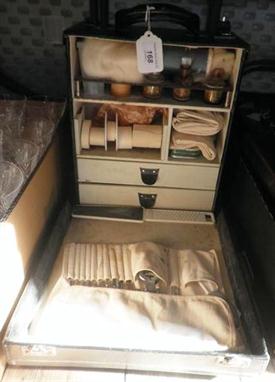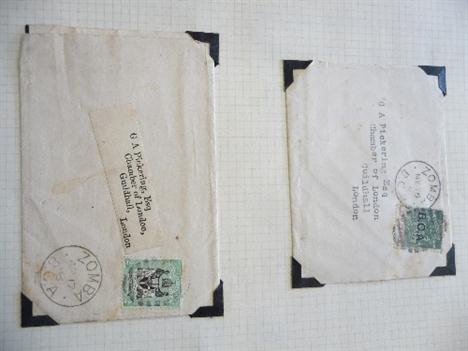We found 596780 price guide item(s) matching your search
There are 596780 lots that match your search criteria. Subscribe now to get instant access to the full price guide service.
Click here to subscribe- List
- Grid
-
596780 item(s)/page
A First World War two medal group awarded to J 71365 A.W. Slade B. Tel RN (War Medal and Victory Medal), a Royal Airforce logbook with entries from November 1921 - March 1927, together with a presentation Chinese pewter box inscribed `Ldg - Tel. A.W. Slade from Lieut Comdr Mackintosh 421 Flight (Nova, Gosport) and HMS Hermes 441 Flight (Mediterranean, China).` A.W. Slade rescued Lieut Comdr Mackintosh after their plane from 421 Flight crashed into the Solent.
A First World War three medal group awarded to M2-051488 Pte. E. Anchorson. A.D.C. - Victory Medal, 1914-15 Star and War Medal; together with a five medal Second World War group awarded to his son - War Medal, Defence Medal, Africa Star, 1939-45 Star, and Italy Star - with a framed photograph of No. 6 Motor Ambulance Convoy, 1939, a military compass, various cap badges etc.
Paul Swan, American School, 1883-1972 `Portrait of Isadora Duncan wearing a blue dress and coloured bead necklace, three quarter length` oil on canvas, signed and dated `22 100cm x 71.5cm Provenance Gift of the artist to Salvatore Cartaino Scarpitta (1887-1948) Enrico Saccone The flamboyant artist and dancer Paul Spencer Swan (1883-1972) had a tempestuous relationship with Isadora Duncan. They first met in Paris where Duncan had moved in 1900. She described Swan famously as `the most beautiful man in the world`. Isadora Duncan completely transformed the concept of ballet, rejecting classical ballet as `ugly and against nature` she introduced the idea of improvisation emphasising emotion and the human form. She gained international fame and became the inspiration for many artists and designers of the day. Such was her fame that by 1913 a portrait of the dancer by sculptor Antoine Bordelle was placed over the entrance of the newly built Theatre des Champs-Elysees. Paul Swan shared Duncan`s philosophy of self- expression both in his work of dancer and artist and in his Bohemian style private life. Both he and Duncan were self confessed bisexuals. It is very probable that they were in sexual relationship however Duncan`s whirlwind personality drew many admirers close only to be dropped again just as quickly. It is alleged that the sculptor Scarpitta made a social visit to Swan`s studio in Los Angeles to find the artist raging before his portrait of Isadora and about to paint it out. Swan had modelled for Scarpitta on many occasions and the two artists were great friends. The sculptor, recognizing the importance of the portrait, persuaded Swan to part with the picture in return for several litres of wine and thus it was saved. The picture remained with the Scarpitta family for many years before being purchased by the present vendor Enrico Seccone. Salvatore Scarpitta had worked on The Victor Emmanuel monument in Rome for the architect Count Giuseppe Seccone (1854 - 1905), the vendor`s grandfather. Reference: Londraville, Janis and Richard - `The Most Beautiful Man in the World - Paul Swan `, published by The University of Nebraska Press, 2006
A group of five 19th century Crimea medals, awarded to Bt. Major Alexander McKinstry, 17th Leicestershire Regiment to include the Al Valore Militaire, Spedizione D`Orient 1855-1856 medal with original inscription, the Turkish Crimea medal (Sardinian version), the Afghanistan medal with Charasia bar, the Crimea medal and The Order of Medjid together with a Leicestershire Hindostan badge, Sebastopol bar, Tiger badge and small 17th Hindostan Leicestershire badge. Major McKinstry was awarded the Sardinian Medal for Military Valour having `Displayed Gallant Conduct on 18 June 1855 at the Assault of The Great Redan`. The Redan was one of the large fortifications that ringed the City of Sebastopol. The first attack on 18 June resulted in failure but the fort was later successfully taken in September. Included in this lot is a circular framed photograph of Major McKinstry on horseback.
Great Britain and Cyprus (Greek and Turkish). A small collection of Great Britain FDC`s from the 1970`s with Forces Post Office First Day cancels. Two volumes of Cyprus (Greek) FDC`s from the 1970`s; 1973 to 1975 Year packs with duplication. Also Cyprus (Turkish) FDC`s from late 1970`s to 1980`s
Nyasaland. A small range of commercial mail on album leaves. Includes 1891 2d on newspaper wrapper with fine Zomba MY16 1895 CDS; 1895 2d on newspaper wrapper with fine Zomba AP17 1896 CDS; 1948 First flight Nyasaland to Southern Rhodesia bearing 4d and 6d with unclaimed cachet. Further First flight cover Nyasaland to Southern Rhodesia bearing 1s
A First World War group of four medals, including Victory, 1914-18, 1914-15 Star and 1935 Jubilee medal, awarded to Lieut. J.P. Charley RN, a set of miniatures, with 1914-18 miniature medal including narrow sea 1918, North Sea 1917, Jutland 31 May 1916, North Sea 1916, Dogger Bank 24 Jan `15, North Sea 1915, North Sea 1914 clasps, and a single First World War Victory medal, awarded to pte. W Pither, R. Berks R.
A First World War and World War Two MBE group of six medals, including Victory, 1914-18, George V Long service and Good Conduct with Indian clasp, 1939-45, Defence Medal and MBE (military), and miniature set of medals, awarded to Captain Alfred Albery M2 101 242, for services during Indian Independence.
A cased set of four Queen Elizabeth II medals, and miniatures, including Korea, a Naval beret, badges, bosun`s whistle, set of Russian maritime badges, two First World War brass Christmas tins, graduated set of six brass tot flagons, a framed Mary Rose oak timber fragment with certificate, etc.
A First Period Worcester porcelain dish of kidney shaped form enamelled in the Lord Henry Thynne pattern with a lakeside landscape, within a border of fruit and birds in flight within a narrow blue and gold border, 26.5 cm wide, hatched crescent mark, circa. 1775-85, foot rim chipped.
A First Period Worcester porcelain cup and saucer of fluted form decorated in underglaze blue vertical panels alternating with floral sprays within a gilt dentil border, 12.5 cm diameter, hatched square mark and bearing labels for the ‘F.S. Mackenna Collection, No. 89’, circa. 1770-80.
Charles Robertson (1844-1891) ‘The Faithful at Prayer’ signed and dated C.Robertson, RWS 1888 bottom right watercolour heightened with white 77 x 132cm. Footnote: An oil painting called The Shoes of The Faithful was exhibited at the R.A. in 1882. Charles Robertson (1844-1891): landscape and genre painter in oils and watercolours and occasional engraver. Robertson travelled extensively from an early age. In 1862, at the age of 18, he travelled for the first time to Algeria which would inspire his first Orientalist work Boufarik Algeria, which he exhibited at The Royal Academy the following year. Later travels would include Turkey, Egypt, Tangiers, Jerusalem and Damascus. He first settled in Aix en Provence. Robertson painted in oils for the early part of his career, exhibiting at the Royal Academy from 1863-1885. In 1880 he began to move towards the use of watercolour and by 1884 he was executing the majority of his work in this medium. Just five years after taking-up this practice he was invited to exhibit at The Royal Watercolour Society becoming a member in 1891. He also became a member or the R.O.I. and the Royal Society of Painters, Etchers and Engravers. From 1864 Robertson had an address at Walton-on-Thames and latterly Godalming, Surrey. A technically accomplished artist, well travelled, best known for his exotic Middle Eastern and Orientalist subjects which he depicted in a manner reminiscent of John Frederick Lewis with bright jewel-like colours. In the last decade of his life he was producing some of his most brilliant work.
-
596780 item(s)/page





































